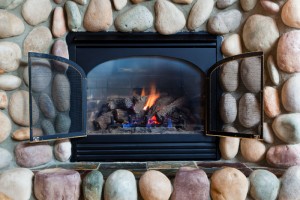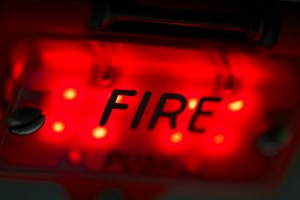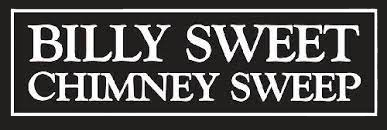by Billy Sweet | Feb 17, 2014 | Chimney Maintenance, Fire Safety

Creosote can’t be prevented, but there are ways to minimize its build up and the effects it may have on your chimney and home, in general.
If you could get on your roof and look down into your chimney (we don’t recommend this), you’d see a lot of black. Wondering what that black element is inside your chimney that totally covers the inside? That’s what we call creosote and it can cause tremendous damage if taken for granted. It has all these harmful chemicals that gradually become highly corrosive and could cause fires to happen inside the chimney. Although the formation of creosote cannot be prevented, it is still best to try and minimize it.
What is Creosote?
Creosote is a highly combustible chemical product obtained by the distillation of tar. It is heavier compared to other chemical products and is famous for its antiseptic and preservative properties. When wood is burned, there is production of creosote. It sticks onto the walls of the chimney after combustion takes place in the fireplace. It is a result of incomplete combustion.
Creosote has two main types:
Generally, wood tar is known for its meat preservation purposes and is known to be nontoxic. It is also used to treat hardwood and softwood to keep them dry until such time. It has been used in the medical field as a laxative or for other purposes like as an antiseptic. Coal tar, on the other hand, contains highly toxic properties. That’s why it is exclusively used for preserving wood only.
Those are the intentional and industrial uses of creosote. It can also be found in blast furnaces, but in a chimney it is found in the flue because wood was not properly burned.
The Three Levels of Creosote Build up
When you have your chimney inspected and cleaned, sometimes our experts will need to do a more thorough cleaning and literal scraping. This happens when there is too much creosote in the chimney walls and, if left there to thicken, might cause bigger problems that will soon become a homeowner’s worst nightmare. This is why creosote build up is described in levels based on the texture, thickness and color.
The first level is still called soot because it has not yet fully developed into creosote. It’s described to be flaky and can be removed easily with a chimney sweeps’ brush. It is still reachable and does not need any special technical equipment.
The second level is already known to be creosote. It’s hard and is already the color brown or black. In this stage, our licensed sweep will have to use specially designed video cameras to check and see the extent of damage done by the creosote. There is now a need for a more durable brush to use in removing the creosote.
For the third and final level, the creosote is already very thick and is now known as glaze. There is no chance for it to completely be removed unless you destroy the entire structure of your chimney – something we all wouldn’t want to do. In this stage, the creosote is highly flammable and has a shiny black texture and with just one false move, you can say bye-bye to your hard-earned home. In this level, constant scraping is done to minimize the thickness. There is a need for bigger equipment and a specially-designed brush to use for scraping off the creosote.
The Risks
Some think that by having a broomstick, you can already remove the creosote. What we have to realize is that there are risks in trying to take matters into our own hands. The biggest risk is fire. It can spark up anytime and only trained professionals know what to do in case this happens and how to put it out before anyone gets hurt. So it’s always best to leave the dirty work to us.
With annual inspections and sweeping, your chimney will not have to endure the aftereffects of what creosote can do. Taking this important step will definitely add more years to its lifespan and the guarantee of a fully-functional, well-maintained chimney. You can contact our company, Billy Sweet Chimney Sweep, because we have the best trained professionals with the right amount of experience to show and prove to you that indeed, we can get the job done right.
by Billy Sweet | Feb 17, 2014 | Chimney Maintenance, Fire Safety

Before your certified chimney sweep comes, it’s good to know the different levels of inspection and what they do in each level.
While it is accurate to say that no two chimneys are the same, it used to also be that no two chimney inspections were the same. This meant that depending on who you hired to do your inspection and subsequent sweeping, the inspection process could be entirely different, with widely varying degrees of thoroughness. Thankfully, in January of 2000, the Chimney Safety Institute of America introduced three levels of chimney inspection and adopted them into code. This means that any chimney sweep who has been certified by the C.S.I.A. (as any sweep should be if he or she is working on your chimney) will conduct one of three levels of inspection according to exacting specifications.
The 3 Levels of Chimney Inspection
The C.S.I.A. has clearly outlined three levels of chimney inspection. Depending on the condition of your chimney and the dangers that exist inside, one of the technicians at Billy Sweet Chimney Sweep will be able to assess which inspection level your chimney warrants. Each inspection utilizes a closed circuit camera to gain a comprehensive look at the flue.
Level 1: The most basic (and most common) inspection looks at all “readily accessible” portions of the inside and outside of the flue, the heating appliance, and its connections.
Level 2: The next level of inspection is recommended when any changes have been made to the heating system. A Level 2 inspection will take a more in-depth look at the chimney and appliance and will include all parts of the chimney made accessible by attics, crawl spaces, and basements.
Level 3: The most comprehensive inspection of all, a Level 3 inspection involves the removal of some components of the chimney or the building to gain full access to the chimney. This inspection is recommended when a Level 2 inspection has indicated that there’s a hidden danger inside your flue.
Read more about chimney inspections here.
Billy Sweet Chimney Sweep is able to serve a wide swath of customers, as we have locations in Eastern Massachusetts, Southern New Hampshire, and Portland, Maine. Contact us today!
by Billy Sweet | Oct 27, 2013 | Chimney Maintenance, Fire Safety
More Than Throwing In Some Newspapers
Many people enjoy using their fireplace during the winter to enjoy a warm fire. However, there are many people who do not know how to properly build a fire. It may seem as though it is as simple as throwing in some logs and lighting a match. However, building a fire safely and properly takes a bit of skill. There are a few simple tips any homeowner can follow to build a safe, roaring fire in their fireplace.

Even though you may want a fire so badly, you are tempted to use green or wet wood – it really hurts you in the long and short run. You’ll have a smoky fire and create additional fire hazards in your chimney.
One of the most important things to keep in mind before beginning a fire is that the fireplace and chimney must be kept clean. Before starting the fire, take a look into the chimney with a flashlight and make sure that there are no obstructions. In many cases, leaves or animals can make their way into the chimney and block it. If this happens, smoke will come right into the home instead of going out through the chimney, which can be unpleasant as well as unsafe for the family.
An essential first step to building a fire is one that many people tend to forget. Before doing anything at all, make sure that the damper is open. In most chimneys, this is done by simply pulling a small cord or handle. The damper opens up the chimney and allows smoke as well as other combustible gasses to exit the home safely. Leaving the damper closed is a common mistake and many people realize it only when the home begins to fill with smoke from the fireplace.
Once the chimney is clear and the damper is open, it is a good idea to prime the flue. When the damper opens, the flue will immediately fill with cold air. It must be warmed up gradually before it is safe to build a big fire in the fireplace. This is best accomplished by lighting a bit of newspaper and holding it under the flue. Once it becomes warm, it will be in perfect condition for a warm, cozy fire.
When building the fire, keep in mind that only certain materials should be burned in the fireplace. Some people choose to use coal but most find seasoned firewood to be the best choice. Before going into the fireplace, wood should be left out to season for about eight months to a year. If anything else is used, the consequences could be disastrous. The fire may burn too hot and fill the house with smoke, which could also lead to a chimney fire. Other materials may also create chemicals that are toxic to everyone in the home.
Of course, keeping the chimney and fireplace clean is an important part of home maintenance. However, it is a good idea to keep a layer of ash measuring about an inch on the bottom of the firebox. This insulates the firebox and helps to burn a strong, warm fire. After each fire, sweep out the fireplace but leave a small layer of ash behind to help insulate the next fire.
Following a few simple tips will not only keep a fire warm and cozy, but it will ensure that it is safe. Before doing anything, make sure that the flue is free of any blockages and that the damper is open to allow smoke out. Start the fire slowly and let it build to a safe and enjoyable glow.
by Billy Sweet | Aug 31, 2013 | Chimney Maintenance, Fire Safety
A house fire is one of the worst situations we can think of ourselves in, especially when we think of home being the safest place we know. A fire can occur at any time, even in the middle of summer, and it is important to be prepared if a fire occurs within the home to keep you and you, your family, pets, and others staying in your home safe. f you have a chimney, it is critical to have it inspected and cleaned annually.

No matter how careful and preventative you are, you can still face a home fire.
Take alarms seriously
When a smoke or carbon monoxide detector goes off, it is for a real warning. Take all precautions seriously from the moment you become aware of an alarm or other problem such as seeing or smelling smoke. If an alarm goes off, GET OUT! It is important to notify the proper authorities, but do so after you have ensured your safety and to those around you.
Fire Extinguishers
Most fires start small and can be contained if acted upon quickly. Use fire extinguishers on small fires if available and accessible. Not only is a fire extinguisher a good protection, be familiar with its operation. Never operate a fire extinguisher if you do not know how to us it.
Take caution with closed doors
When evacuating a house that is on fire, always feel the door handle to see if it is hot. Never open a door if the handle is hot. Opening the door can bring more oxygen to the fire feeding it and possibly bringing you into more danger. Find another way out of the room. If you cannot escape, signal for help. Window ladders can be useful for second story rooms. Never use a non-approved ladder.
Stay low to the ground
Heat and smoke will rise, so being close to the floor will help keep you safer. Keeping low to the ground will help reduce the amount of smoke inhalation. Crawl and keep your hand on the wall to keep from being disoriented.
Once out Stay Out
Once you reach safety, dial 911 if someone has not already, and never re-enter a burning building. Stay clear from danger and await for authorities to arrive.
Have a Plan
The most important thing to consider about home fire safety is to have a plan. Practice as a whole household proper procedures in case there is a fire. Pick a spot a safe distance from your home as a meet-up spot to gather in case of a fire. Fire extinguishers, ladders, and proper procedures for exiting a burning house or building will help keep you and your loved ones safe.




